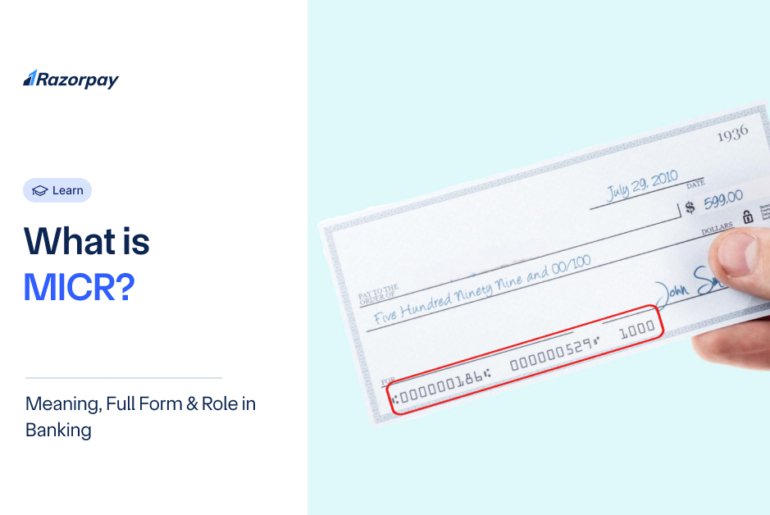Table of Contents
What is Magnetic Ink Character Recognition (MICR)?
MICR stands for Magnetic Ink Character Recognition. It is a method of encoding characters using magnetic ink and special fonts to make printed or handwritten information machine-readable. The MICR magnetic ink contains iron oxide particles, which generate magnetic signals when passed through a magnetic ink character reader.
The characters used in MICR encoding are typically numbers and symbols, representing essential information found on financial documents, primarily cheques. The magnetic ink MICR line on a cheque contains three key components:
- Bank Routing Number
- Account Number
- Cheque Number
These components ensure that funds are withdrawn from the correct account and routed to the appropriate financial institution for processing.
MICR: Full Form and Meaning
As mentioned earlier, the MICR full form is Magnetic Ink Character Recognition. It refers to the technology that uses magnetic ink and standardised fonts (E-13B or CMC-7) to print machine-readable characters on financial documents. The magnetic character recognition process helps automate cheque clearance and reduces manual data entry, leading to faster and more accurate transactions.
The three key components of the MICR line are:
1. Bank Routing Number
The first set of characters represents the bank’s unique routing number, which helps route the cheque to the correct financial institution for processing.
2. Account Number
The second set of characters denotes the account number associated with the cheque, ensuring funds are withdrawn from or deposited into the correct account.
3. Cheque Number
The final set of characters represents the cheque number, helping in tracking and organising cheques for both the payer and payee.
The History and Evolution of MICR in Banking
The origins of MICR ink can be traced back to the 1950s when the American Bankers Association (ABA) sought ways to streamline cheque processing. The committee’s solution involved using magnetic ink to imprint a distinctive code at the bottom of cheques, encompassing all essential information regarding the account holder and the transaction.
Over the years, MICR technology has evolved to meet modern banking needs. Specialised machines known as MICR readers were designed to swiftly and accurately interpret the magnetic ink characters, transmitting the data efficiently to the bank’s computer system. This advancement has made cheque processing faster and less prone to errors.
In India, MICR was introduced by the Reserve Bank of India (RBI) in the 1980s to modernise cheque clearing. The 9-digit MICR code (e.g., 700002021) became critical:
First 3 digits: City code (linked to PIN codes).
Middle 3 digits: Bank code.
Last 3 digits: Branch code.
Over time, MICR integrated with Cheque Truncation Systems (CTS-2010), enabling real-time digital processing while retaining physical cheque security.
Why MICR is Important in Modern Banking
- High-speed and accurate reading of encoded information on cheques
- Reduced errors and minimised fraud risks
- Facilitated automated processing of cheques, enhancing overall efficiency
- Improved customer service through faster transaction processing
How MICR Encoding and Decoding Works
The MICR encoding process involves printing characters using magnetic ink containing iron oxide particles. The characters are printed in a specific font, creating unique patterns that MICR readers can recognise and decode.
During the decoding process, the MICR-encoded document is passed through a magnetic ink character reader, which detects the magnetic signals generated by the iron oxide particles. The reader translates these signals into the corresponding characters, extracting essential information such as account numbers and routing details with high accuracy.
Advantages of MICR Technology in Banking
1. Faster Cheque Processing & Clearance
MICR enables the automated and accurate processing of cheques through high-speed machines, facilitating the efficient movement of cheques between banks.
2. Enhanced Accuracy
Automated MICR systems can read characters at high speeds, reducing the likelihood of errors associated with manual data entry.
3. Fraud Prevention
The unique combination of numbers and characters in MICR is difficult to alter or forge without leaving noticeable evidence, helping banks verify cheque authenticity and reduce fraud risks.
4. Regulatory Compliance
Many regulatory bodies mandate the use of MICR technology for cheque processing to ensure banks operate securely and reliably.
5. Less Manual Work
Automated MICR readers and sorting machines significantly reduce the need for manual intervention, speeding up processing and minimising human errors.
Conclusion
MICR technology ensures fast, accurate, and secure cheque processing, reducing fraud risks through tamper-proof magnetic ink and standardised encoding. Even in the age of digital payments, it remains critical to handle physical cheques, particularly in regions like India, where cheque-based transactions persist.
As banking technologies evolve, MICR is poised to adapt and integrate with emerging trends, providing enhanced security and convenience to customers in an increasingly cashless economy.
Frequently Asked Questions (FAQs)
1. Can MICR be printed on any printer?
No, MICR requires specialised printers that use magnetic ink and adhere to strict printing standards to ensure machine-readability.
2. Is MICR still relevant with digital banking?
Yes, while digital payments are on the rise, MICR remains crucial for processing physical cheques and preventing payment fraud.
3. What type of ink is used in MICR?
MICR uses magnetic ink containing iron oxide particles for machine-readable signals.
4. Can MICR characters be scanned with a regular scanner?
No, regular scanners cannot read MICR characters.



